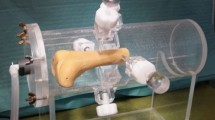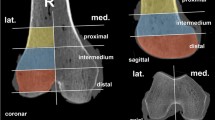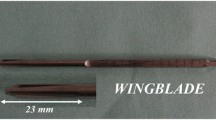Abstract
Introduction
The increasing number of geriatric traumatology cases has intensified the need to reliably and objectively evaluate local bone quality, the latter poses a decisive factor for the choice of an optimal approach to treat osteoporotic fractures. Osteodensitometry imaging techniques are not routinely available in acute operative settings, nor do they provide objective information on local bone properties specifically needed for the prognosis of implant stability.
Materials and methods
This study sought to verify ex vivo the feasibility and sensitivity of a novel method for the determination of local bone strength in the acute operative setting (intraoperative osseomechanical strength measurement; IOSM) that is based on the principle of material displacement resistance against the force of a rotary indenter. Samples consisted of human femoral heads obtained after total hip replacement. Comparisons were made with results obtained via conventional dual-energy X-ray absorptiometry (DXA) and quantitative computed tomography (qCT).
Results
Regression analyses of the results showed a highly significant correlation between the IOSM and the control methods (r = 0.61 and r = 0.56; p < 0.01), indicating that this new approach qualifies as a reliable tool for the intraoperative evaluation of the intrinsic local bone strength.
Conclusions
The intraoperative integration of this method may support surgeon on taking proper decisions in terms of optimal surgical approaches and prevention of complications inherent to osteoporotic bone.








Similar content being viewed by others
References
Czerwiński E, Badurski JE, Marcinowska-Suchowierska E, Osieleniec J (2007) Current understanding of osteoporosis according to the position of the World Health Organization (WHO) and International Osteoporosis Foundation. Ortop Traumatol Rehabil 9:337–356
Eisenmenger M, Pötzsch O, Sommer B et al (2007) Bevölkerung Deutschlands bis 2050—11. koordinierte Bevölkerungsvorausberechnung. Statistisches Bundesamt, Wiesbaden
Papaioannou A, Kennedy CC, Ioannidis G et al (2009) The impact of incident fractures on health-related quality of life: 5 years of data from the Canadian Multicentre Osteoporosis Study. Osteoporos Int 20:703–714. https://doi.org/10.1007/s00198-008-0743-7
Adachi JD, Loannidis G, Berger C et al (2001) The influence of osteoporotic fractures on health-related quality of life in community-dwelling men and women across Canada. Osteoporos Int 12:903–908
Davis TR, Sher JL, Horsman A et al (1990) Intertrochanteric femoral fractures. Mechanical failure after internal fixation. J Bone Joint Surg Br 72:26–31
Barrios C, Broström LA, Stark A, Walheim G (1993) Healing complications after internal fixation of trochanteric hip fractures: the prognostic value of osteoporosis. J Orthop Trauma 7:438–442
Bonnaire F, Zenker H, Lill C et al (2005) Treatment strategies for proximal femur fractures in osteoporotic patients. Osteoporos Int 16:S93–S102. https://doi.org/10.1007/s00198-004-1746-7
Bonnaire F, Weber A, Bösl O et al (2007) “Cutting out” bei pertrochantären frakturen—ein problem der osteoporose? Unfallchirurg 110:425–432. https://doi.org/10.1007/s00113-007-1248-0
Bartucci EJ, Gonzalez MH, Cooperman DR et al (1985) The effect of adjunctive methylmethacrylate on failures of fixation and function in patients with intertrochanteric fractures and osteoporosis. J Bone Joint Surg Am 67:1094–1107
Kammerlander C, Gebhard F, Meier C et al (2011) Standardised cement augmentation of the PFNA using a perforated blade: a new technique and preliminary clinical results. a prospective multicentre trial. Injury 42:1484–1490. https://doi.org/10.1016/j.injury.2011.07.010
Baruffaldi F, Barbanti Brodano G, Testoni M et al (1996) Femoral densitometry as potential preoperative indicator for cementation of hip prosthesis. Radiol Med 92:193–198
Ammann P, Rizzoli R (2003) Bone strength and its determinants. Osteoporos Int 14:13–18. https://doi.org/10.1007/s00198-002-1345-4
Atsumi M, Park S-H, Wang H-L (2007) Methods used to assess implant stability: current status. Int J Oral Maxillofac Implants 22:743–754
Suhm N, Hengg C, Schwyn R et al (2007) Mechanical torque measurement predicts load to implant cut-out: a biomechanical study investigating DHS® anchorage in femoral heads. Arch Orthop Trauma Surg. https://doi.org/10.1007/s00402-006-0265-8
Grote S, Noeldeke T, Blauth M et al (2013) Mechanical torque measurement in the proximal femur correlates to failure load and bone mineral density ex vivo. Orthop Rev 5:77–81. https://doi.org/10.4081/or.2013.e16
Mueller MA, Hengg C, Hirschmann M et al (2012) Mechanical torque measurement for in vivo quantification of bone strength in the proximal femur. Injury 43:1712–1717
Taylor WR, Szwedowski TD, Heller MO et al (2012) The difference between stretching and splitting muscle trauma during THA seems not to play a dominant role in influencing periprosthetic BMD changes. Clin Biomech 27:813–818. https://doi.org/10.1016/j.clinbiomech.2012.05.004
Müller MA, Hengg C, Krettek C et al (2015) Trabecular bone strength is not an independent predictive factor for dynamic hip screw migration—a prospective multicenter cohort study. J Orthop Res 33:1680–1686. https://doi.org/10.1002/jor.22934
Trudel G, Koike Y, Dinh L, Uhthoff HK (2005) Thawing of frozen calcaneus bone specimens has no effect on the bone mineral density using dual energy X-ray absorptiometry: a study in rabbits and humans. Physiol Meas 26:769–777. https://doi.org/10.1088/0967-3334/26/5/015
Whitehouse RW, Economou G, Adams JE (1993) Influence of temperature on QCT: implications for mineral densitometry. J Comput Assist Tomogr 17:945–951
Lenich A (2005) Der trochantäre Fixationsnagel (TFN) im biomechanischen Test. In: DGU-DGOT Tagung. p 670
Bonnaire FA, Buitrago-Tellez C, Schmal H et al (2002) Correlation of bone density and geometric parameters to the mechanical strength of the femoral neck. Injury 33(Suppl 3):C47–53
Ahrengart L, Tornkvist H, Fornander P et al (2002) A randomized study of the compression hip screw and gamma nail in 426 fractures. Clin Orthop Relat Res 401:209–222
Brammar TJ, Kendrew J, Khan RJK, Parker MJ (2005) Reverse obliquity and transverse fractures of the trochanteric region of the femur; a review of 101 cases. Injury 36:851–857. https://doi.org/10.1016/j.injury.2005.02.004
Herrera A, Domingo L, Calvo A et al (2002) A comparative study of trochanteric fractures treated with the Gamma nail or the proximal femoral nail. Int Orthop 26:365–369. https://doi.org/10.1007/s00264-002-0389-6
Hohendorff B, Meyer P, Menezes D et al (2005) Behandlungsergebnisse und Komplikationen nach PFN-osteosynthese. Unfallchirurgie 108:938–953. https://doi.org/10.1007/s00113-005-0962-8
Werner-Tutschku W, Lajtai G, Schmiedhuber G et al (2002) Intra- und perioperative Komplikationen bei der Stabilisierung von per- und subtrochantären Femurfrakturen mittels PFN ®. Unfallchirurgie 105:881–885. https://doi.org/10.1007/s00113-002-0416-5
Schipper IB, Marti RK, van der Werken C (2004) Unstable trochanteric femoral fractures: extramedullary or intramedullary fixation. Review of literature. Injury 35:142–151
Parker MJ, Handoll HH (2010) Gamma and other cephalocondylic intramedullary nails versus extramedullary implants for extracapsular hip fractures in adults. Cochrane Database Syst Rev. https://doi.org/10.1002/14651858.CD000093.pub5
Parker M, Handoll H (2005) Gamma and other cephalocondylic intramedullary nails versus extramedullary implants for extracapsular hip fractures in adults. In: Parker M (ed) Cochrane Database Syst Rev Wiley, Chichester, p CD000093
Center JR, Nguyen TV, Pocock NA, Eisman JA (2004) Volumetric bone density at the femoral neck as a common measure of hip fracture risk for men and women. J Clin Endocrinol Metab 89:2776–2782. https://doi.org/10.1210/jc.2003-030551
Black DM, Cummings SR, Karpf DB et al (1996) Randomised trial of effect of alendronate on risk of fracture in women with existing vertebral fractures. Fracture Intervention Trial Research Group. Lancet (Lond, Engl) 348:1535–1541
Kanis JA, Glüer CC (2000) An update on the diagnosis and assessment of osteoporosis with densitometry: Committee of Scientific Advisors, International Osteoporosis Foundation. Osteoporos Int 11:192–202
Goulet RW, Goldstein SA, Ciarelli MJ et al (1994) The relationship between the structural and orthogonal compressive properties of trabecular bone. J Biomech 27:375–389
Beck TJ, Ruff CB, Warden KE et al (1990) Predicting femoral neck strength from bone mineral data: A structural approach. Invest Radiol 25:6–18
Cummings SR, Black DM, Nevitt MC et al (1993) Bone density at various sites for prediction of hip fractures. The Study of Osteoporotic Fractures Research Group. Lancet 341:72–75
Lotz JC, Gerhart TN, Hayes WC (1990) Mechanical properties of trabecular bone from the proximal femur: a quantitative CT study. J Comput Assist Tomogr 14:107–114
Lotz JC, Hayes WC (1990) The use of quantitative computed tomography to estimate risk of fracture of the hip from falls. J Bone Joint Surg Am 72:689–700
Bonnaire FA, Weber AT (2002) Analysis of fracture gap changes, dynamic and static stability of different osteosynthetic procedures in the femoral neck. Injury 33(Suppl 3):C24–32
Funding
There is no funding source.
Author information
Authors and Affiliations
Corresponding author
Ethics declarations
Conflict of interest
The authors declare that they have no conflict of interest.
Ethical approval
This article does not contain any studies with human participants or animals performed by any of the authors.
Additional information
Publisher's Note
Springer Nature remains neutral with regard to jurisdictional claims in published maps and institutional affiliations.
Rights and permissions
About this article
Cite this article
Maslaris, A., Brinkmann, O., Layher, F. et al. A novel method for intraoperative osseomechanical strength measurements: a biomechanical ex vivo evaluation on proximal femora. Arch Orthop Trauma Surg 140, 727–734 (2020). https://doi.org/10.1007/s00402-019-03284-7
Received:
Published:
Issue Date:
DOI: https://doi.org/10.1007/s00402-019-03284-7




